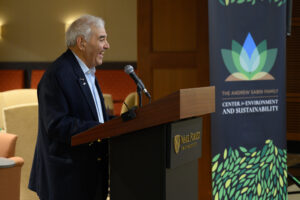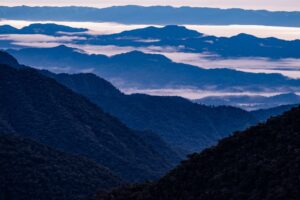Center for Amazonian Scientific Innovation (CINCIA)
The Center for Amazonian Scientific Innovation (CINCIA) was established in 2016, when Wake Forest University received nearly $10 million in support from USAID and other private sector partners. CINCIA was established through CEES and aims to develop transformative solutions to promote sustainable use of tropical landscapes, combat environmental destruction and improve human health in the Amazonian province of Madre de Dios (MDD) in Peru. The U.S. Agency for International Development (USAID) announced the award of $2.5 million to help establish CINCIA, an alliance of U.S. and Peruvian institutions led by experienced scientists, conservationists and affiliates. An additional $7 million in support, including cash and in-kind contributions, has come from the Amazon Aid Foundation, Ecosphere Capital Partners/Athelia Climate Change Fund, ESRI Global Inc., World Wildlife Fund (WWF) and Universidad de Ingeniería y Tecnología (UTEC). The official announcement of the launch of CINCIA was made on Earth Day, April 22, 2016, during a celebration event hosted by the U.S. Ambassador to Peru, Brian A. Nichols, at UTEC in Lima, Peru.
In just three years, CINCIA has become the international hub for Peruvian and foreign scientists and affiliates to collaborate on critical priorities in Madre de Dios, including: the humanization of gold miners as a way of genuinely gaining their trust and thus access to their land concessions for field research, two nurseries efficiently and inexpensively growing more than 30 varieties of native tree seedlings, Amazonia’s first biochar operation that has proven essential in CINCIA’s restoration and reforestation of once-lush rainforest test plots, the reduction of human health threats from environmental mercury by interacting directly with indigenous peoples who live in the jungles, detection of deforestation threats, and sustainability.
A central goal of CINCIA is to build scientific capacity needed in the local communities to face the growing environmental threats to the people and the region’s rainforests. A supporting goal, which is gaining prominence in the third year of the grant, is education outreach in public schools, science-based curriculum building, pioneering alliances between education leaders in the national government and the local communities, and maintaining the growing profiles of our lead scientists in communicating the dramatic outcomes of their field work.
Through collaborative research, innovative education programs and apprenticeships, the Centro de Innovación Científica Amazónica aims to inspire and groom future local scientists while also engaging with the local community to create the sense of ownership needed to foster change and implement sustainable practices in Amazonia. The Centro de Innovación Científica Amazónica has operated in partnership with the region’s primary research institutions – the Peruvian Amazon Research Institute (IIAP) and the National Amazonian University of Madre de Dios (UNAMAD), the sole national university in the region. IIAP is a governmental research entity under the Peruvian Ministry of the Environment with a 35-year history of scientific investigation in the Amazon.
The vision for this project was inspired by the work of CEES Fellow Sarah DuPont, founder of the Amazon Aid Foundation and her work to build awareness of the Amazon through her film River of Gold. The Centro de Innovación Científica Amazónica has been led by the efforts of Wake Forest conservation biologist and CEES director, Miles Silman, who serves as the associate director for science; longtime colleague and a leading expert on mercury in the Amazon, Luis Fernandez, who serves as executive director; and Justin Catanoso, CEES Board Member, journalism professor, international environmental journalist and communications and management consultant to the CINCIA team in Madre de Dios.
Recent Posts
- Sabin Center Executive Director Honored for Excellence in Public Service
 On April 15, the American Society for Public Administration (ASPA) honored Executive Director Dr. Stan Meiburg with the John W. Gaston Award. In selecting Dr. Meiburg, the ASPA recognized his “longstanding leadership and commitment to the protection and strengthening of our natural resources and public health.” Beyond his 39 years with the Environmental Protection Agency, […]
On April 15, the American Society for Public Administration (ASPA) honored Executive Director Dr. Stan Meiburg with the John W. Gaston Award. In selecting Dr. Meiburg, the ASPA recognized his “longstanding leadership and commitment to the protection and strengthening of our natural resources and public health.” Beyond his 39 years with the Environmental Protection Agency, […] - WFU commits to 100% renewable energy
 University partners with eight colleges and universities for large-scale solar facility Wake Forest University has announced that it is joining forces with eight other colleges and universities in North Carolina and Pennsylvania to bring a large-scale solar facility onto the U.S. electrical power grid in western Kentucky. By collaborating on this Power Purchase Agreement […]
University partners with eight colleges and universities for large-scale solar facility Wake Forest University has announced that it is joining forces with eight other colleges and universities in North Carolina and Pennsylvania to bring a large-scale solar facility onto the U.S. electrical power grid in western Kentucky. By collaborating on this Power Purchase Agreement […] - Celebrating a New Chapter
 Ribbon-Cutting Event Commemorates New Space and Inspires a Path Forward Last Wednesday, March 27, the Andrew Sabin Family Center for Environment and Sustainability was delighted to host Andrew Sabin and his family for a ribbon-cutting ceremony in our new space on campus at Wake Forest University. The ceremony marks the official celebration of the generous […]
Ribbon-Cutting Event Commemorates New Space and Inspires a Path Forward Last Wednesday, March 27, the Andrew Sabin Family Center for Environment and Sustainability was delighted to host Andrew Sabin and his family for a ribbon-cutting ceremony in our new space on campus at Wake Forest University. The ceremony marks the official celebration of the generous […] - Oportunidad de investigación
 Evaluación de la eficacia del desarrollo de capacidades en la gestión de áreas protegidas en Perú El proyecto “Ciencia y Gestión Efectiva de Áreas Naturales Protegidas en Perú” es un esfuerzo de 3 años entre la Universidad Wake Forest, la Pontificia Universidad Católica del Perú y el Centro de Gestión de Áreas Protegidas de la […]
Evaluación de la eficacia del desarrollo de capacidades en la gestión de áreas protegidas en Perú El proyecto “Ciencia y Gestión Efectiva de Áreas Naturales Protegidas en Perú” es un esfuerzo de 3 años entre la Universidad Wake Forest, la Pontificia Universidad Católica del Perú y el Centro de Gestión de Áreas Protegidas de la […] - Research Opportunity: Bilingual
 Opportunity for Research: Evaluating the Effectiveness of Capacity Development on Protected Areas Management in Peru The “Science and Capacity Development for Peruvian National Parks” project is a 3-year effort between Wake Forest University, the Pontifical Catholic University in Perú, and Colorado State University´s Center for Protected Area Management, carried out in close cooperation with the […]
Opportunity for Research: Evaluating the Effectiveness of Capacity Development on Protected Areas Management in Peru The “Science and Capacity Development for Peruvian National Parks” project is a 3-year effort between Wake Forest University, the Pontifical Catholic University in Perú, and Colorado State University´s Center for Protected Area Management, carried out in close cooperation with the […] - Researchers support Peruvian National Parks with help of $2.5M grant
 Wake Forest University will partner with two other universities to support the work of the Peruvian National Park Service by connecting scientists with park managers and policy makers in new ways. The work is funded by a $2.5 million grant from the Gordon and Betty Moore Foundation. Wake Forest’s Andrew Sabin Family Center for Environment […]
Wake Forest University will partner with two other universities to support the work of the Peruvian National Park Service by connecting scientists with park managers and policy makers in new ways. The work is funded by a $2.5 million grant from the Gordon and Betty Moore Foundation. Wake Forest’s Andrew Sabin Family Center for Environment […]
